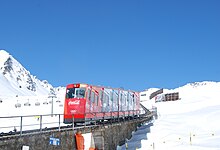Parsenn Funicular
| Parsennbahn | |
|---|---|
 Lower section train approaching Höhenweg (2007) | |
| Overview | |
| Other name(s) | Davos-Parsenn-Bahn; Drahtseilbahn Davos-Parsenn |
| Status | In operation |
| Owner | Davos Klosters Bergbahnen AG (since 2003); AG Drahtseilbahn Davos-Parsenn (D.P.B.) (1931–‥, name change); AG Davos-Parsenn-Bahnen (DPB) (‥–2003) |
| Locale | Davos, Switzerland |
| Termini |
|
| Stations | 3 (2 each, sections meet at Höhenweg) |
| Service | |
| Type | funicular railway, 2 sections |
| Operator(s) | Davos Klosters Bergbahnen AG |
| Rolling stock | 2 each section |
| History | |
| Opened | 17 December 1931 (1st section) |
| Technical | |
| Track length | 4,048 metres (13,281 ft) |
| Number of tracks | 1 with passing loops |
| Track gauge | 1,200 mm (3 ft 11+1⁄4 in) 800 mm (2 ft 7+1⁄2 in) |
| Electrification | from opening |
| Operating speed | 10 metres per second (33 ft/s) 6.2 metres per second (20 ft/s) |
| Highest elevation | 2,665 m (8,743 ft) |
| Maximum incline | 47.7% |

The Parsenn Funicular (German: Davos Parsenn Bahn, DPB) is a funicular railway in the resort of Davos in the Swiss canton of Graubünden. The line links the town of Davos with the Weissfluhjoch ridge and the Parsenn ski area.[1]
The funicular is composed of two separate and independent sections, with an interchange station between the two at Höhenweg. The lowest station (Davos DKB) lies at an elevation of 1,560 metres (5,120 ft) and the highest (Weissfluhjoch DKB) lies at an elevation of 2,665 metres (8,743 ft).[2] The highest section is the highest open-air funicular in Switzerland and the second highest after the Metro Alpin.
Considering both sections, which have a total length of 4,048 metres (13,281 ft), the line is also one of the longest in the country.[1]
The funicular is operated by Davos Klosters Bergbahnen AG.
History[edit]
The funicular opened in December 1931, to access the Weissfluhjoch ski area.[3] The lower section was renovated with two new cars in December 2002,[1] With the upper section being renovated in 2010.[4]
Operation[edit]

The line has the following parameters:[1]
| Feature | Lower section | Upper section |
|---|---|---|
| Number of cars | 2x2 car train sets | 2x2 car train sets |
| Number of stops | 2 | 2 |
| Configuration | Single track with passing loop | Single track with passing loop |
| Track length | 1,860 metres (6,100 ft) | 2,188 metres (7,178 ft) |
| Rise | 662 metres (2,172 ft) | 444 metres (1,457 ft) |
| Maximum gradient | 47,7% | 33% |
| Track gauge | 1,200 mm (3 ft 11+1⁄4 in) | 800 mm (2 ft 7+1⁄2 in) |
| Capacity | 200 passengers per train set | 170 passengers per train set |
| Maximum speed | 10 metres per second (33 ft/s) | 6.2 metres per second (20 ft/s) |
| Journey time | 4 minutes | 10 minutes |
See also[edit]
Further reading[edit]
- Pfister, Max (1982), "Parsennbahn - Ein Höhepunkt des Bergbahnbaus", 50 Jahre Davos-Parsennbahn; Ein Kapitel Skisport-, Kurorts- und Bergbahngeschichte (in German), Davos: AG Davos-Parsenn-Bahnen, pp. 41–50
- Muller, A.-E. (1934), "Le funiculaire Davos-Parsenn", Bulletin Technique de la Suisse Romande (in French), 60: 147–151
References[edit]
- ^ a b c d "DPB - Davos Parsenn Bahn". Funimag. Retrieved 13 January 2014.
- ^ Weissfluhjoch (1:25,000) (Map). Swisstopo. Retrieved 10 April 2019.
- ^ "A New Swiss Mountain Railway", Railway Gazette: 819, 25 December 1931
- ^ "110-SPB Höhenweg-Weissfluhjoch (Davos)". Bergbahnen.org (in German).
External links[edit]
 Media related to Parsennbahn at Wikimedia Commons
Media related to Parsennbahn at Wikimedia Commons- Lower section and upper section on YouTube
46°49′23″N 9°49′11″E / 46.8231°N 9.8196°E
